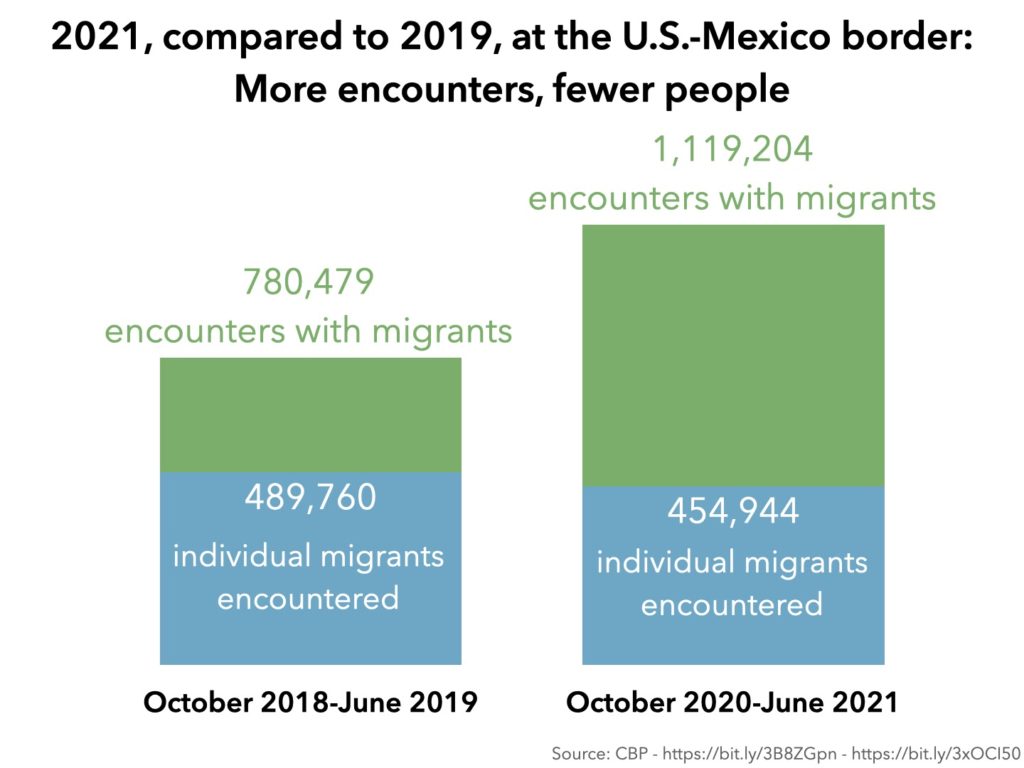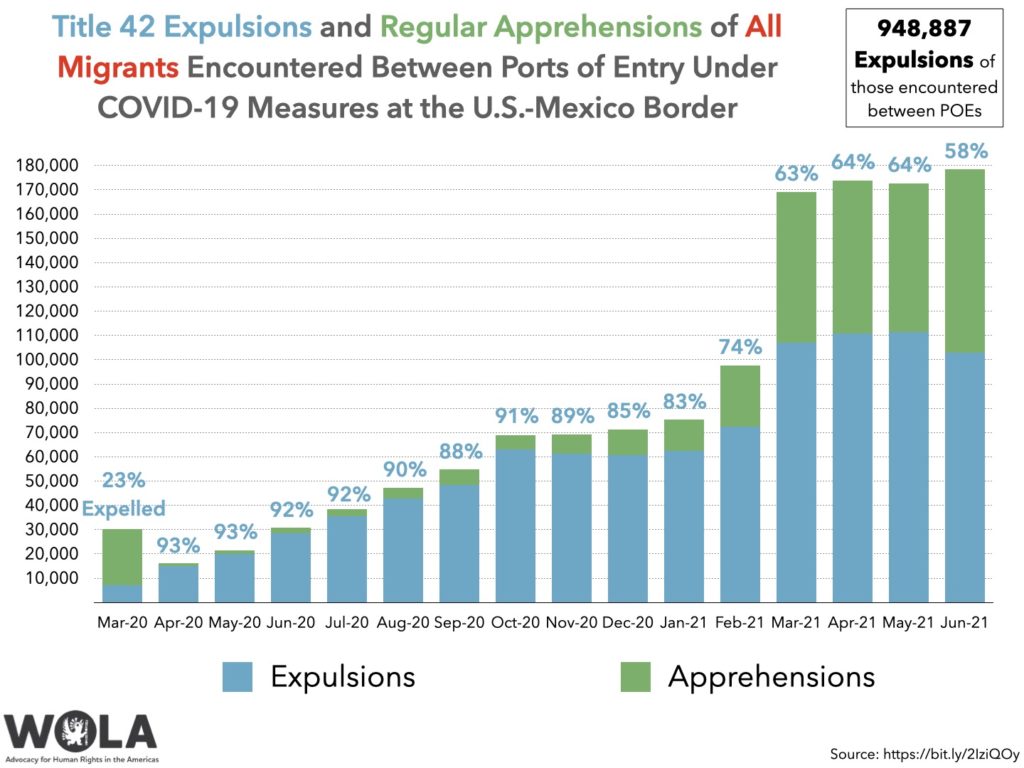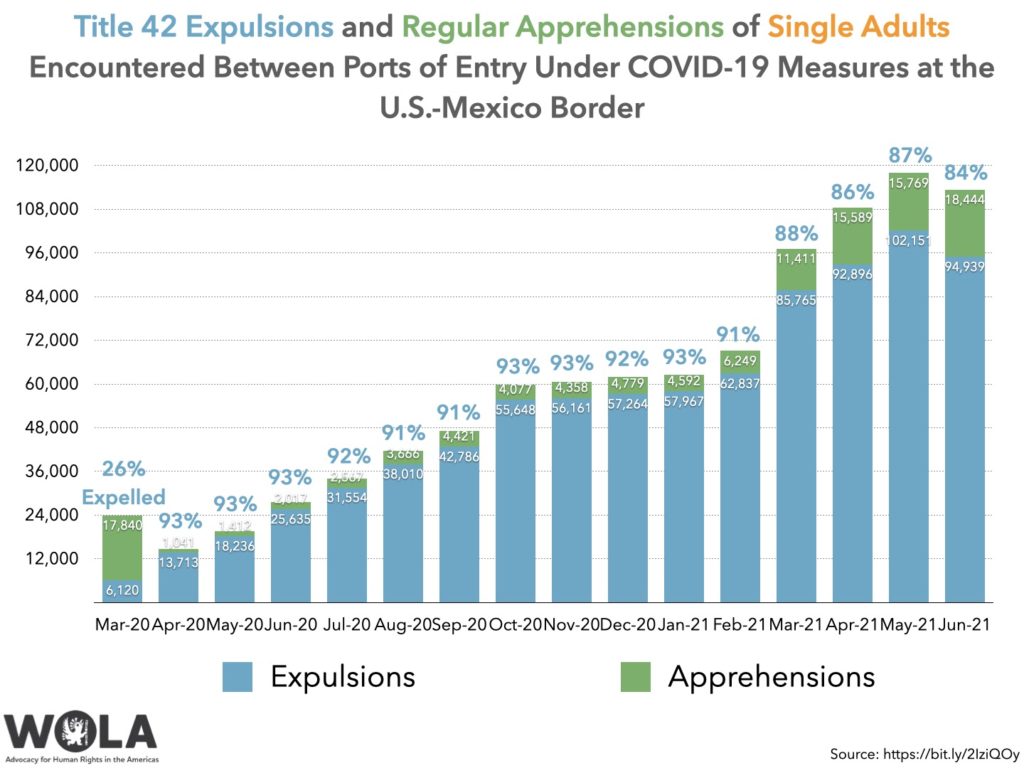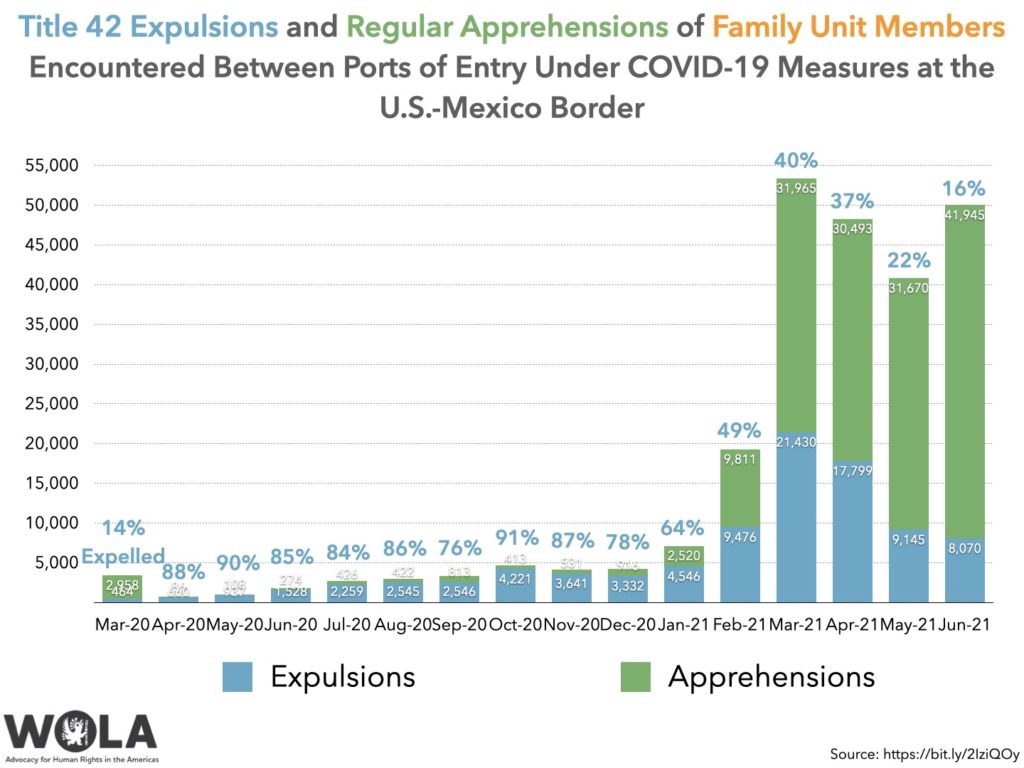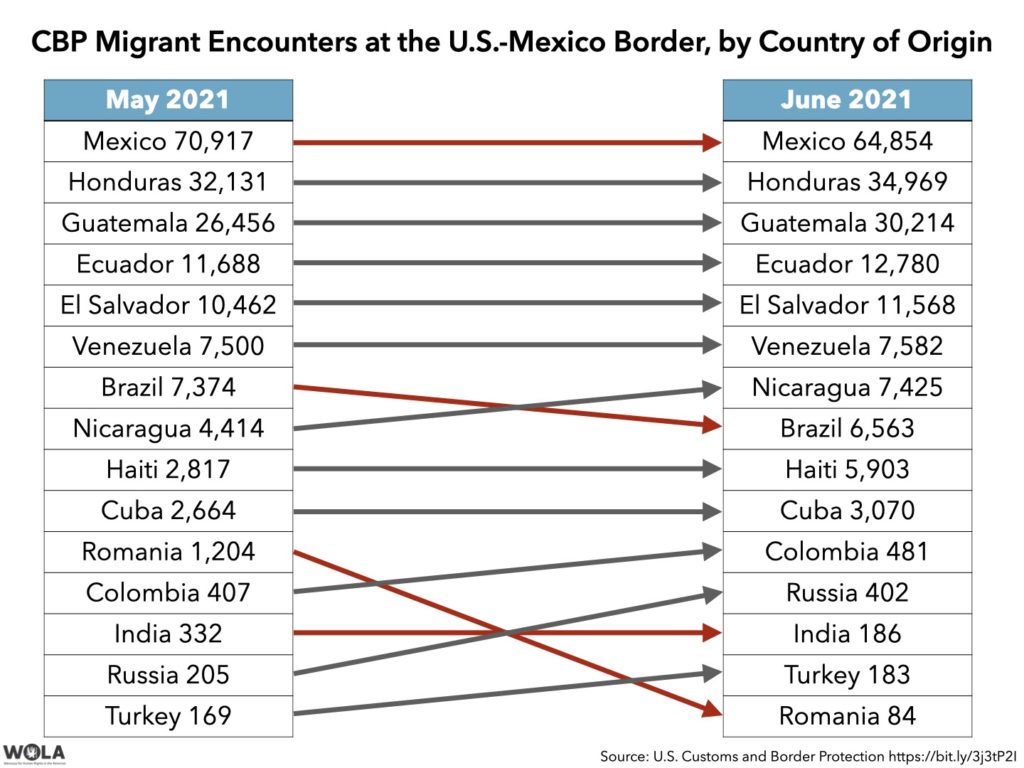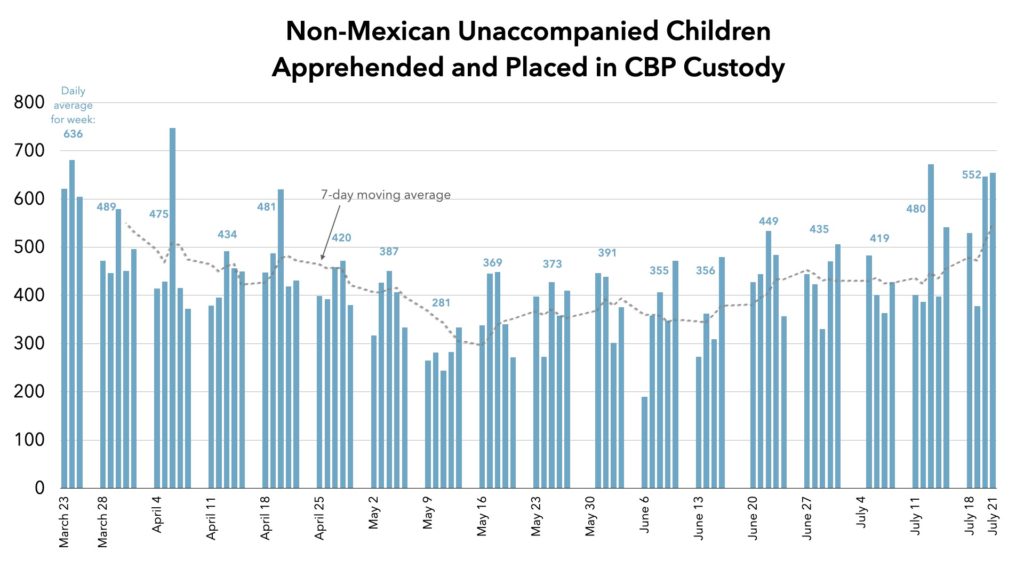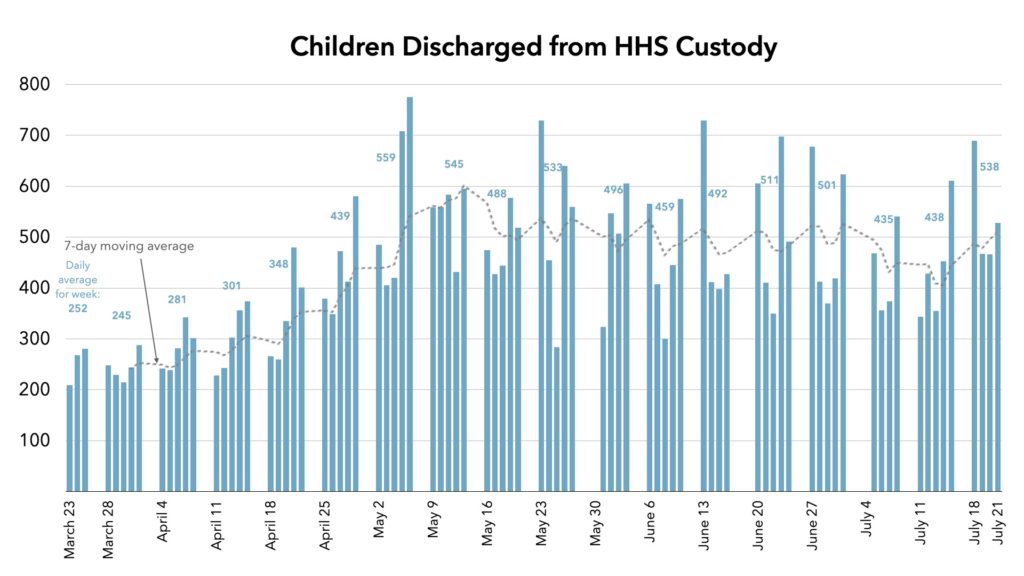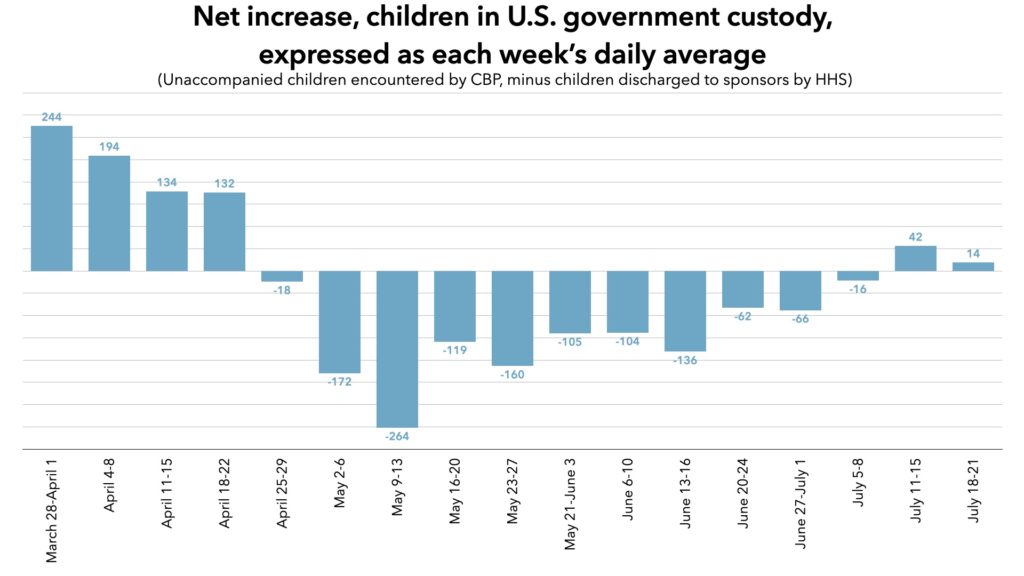With this series of weekly updates, WOLA seeks to cover the most important developments at the U.S.-Mexico border. See past weekly updates here. (Subsequent updates will go in-depth into Vice President Harris’s planned visit to the border this Friday, as reported by media on June 23).
Subscribe to the weekly border update
Support the Beyond the Wall campaign
Key trends from June migration data
On July 16, just after we posted last week’s update, Customs and Border Protection (CBP) published statistics detailing its encounters with migrants at the U.S.-Mexico border during the month of June 2021. The agency reported a 4.5 percent increase in migrant “encounters” from May to June. As we noted last week, this is only the third time this century that migration in the scorching-hot month of June has increased over May.
In all, 188,829 migrants were “encountered” in June: 10,413 at the official land ports of entry, and 178,416 between the ports of entry where Border Patrol operates. This would appear to be the fifth-largest monthly total this century, and the most since 2000.
However, pandemic border measures in effect since the Trump administration have complicated comparisons. The “Title 42” policy, under which most undocumented migrants are swiftly expelled, usually into Mexico (104,907 times in June), has greatly eased repeat attempts to cross the border, so there is a lot of double, triple, and quadruple-counting. “Being expelled carries no legal consequences, so many people try to cross multiple times,” the Associated Press explains.
A large number of “encountered” migrants—34 percent of them in June—are so-called “recidivists”: individuals whom CBP has already encountered in fiscal 2021. (This is a very high recidivism rate: according to CBP’s 2022 budget request, this rate was 12 percent in 2016, 11 percent in 2017 and 2018, 7 percent in 2019, then jumped to 26 percent in 2020.)
With so many repeat crossers, the actual number of people crossing the border is far smaller—in fact, much smaller than we had expected. CBP’s release accompanying the June migration numbers explains, “The number of unique new encounters in June 2021 was 123,838. [That is far less than 188,829.] The number of unique individuals encountered to date during the fiscal year is 454,944 compared to 489,760 during the same time period in 2019.”
If that last sentence is truly accurate, then the number of individual migrants so far this year is less than half the number of encounters (1,119,204), and fewer than it was at this point in 2019. Here is that remarkable data point expressed as a graphic:
When Border Patrol encountered migrants between the ports of entry, it used Title 42 authority to expel them 58 percent of the time, the lowest percentage since the pandemic measures went into place.
When those migrants were single adults, Title 42 expulsions happened 84 percent of the time, down from over 90 percent during the Trump years. As most “recidivist” border crossers are single adults, this population has grown nearly fivefold since Title 42 went into place. June 2021 was, however, the first time since the pandemic began that the monthly number of single adult encounters declined.
After two months of declines in April and May, the number of encounters with families and unaccompanied children increased in June, though not to the high levels experienced in March. The Biden administration is not expelling children who arrive unaccompanied, and has gradually reduced expulsions of the number of family members: 16 percent of encountered family members were expelled in June, down from 40 percent in March.
Recent months have seen notable increases in migrants from neither Mexico nor the Northern Triangle: 26 percent of all Border Patrol encounters in June, and 44 percent of encounters with families, were with citizens of these “other” countries. For the second straight month, Ecuador was the number-four country of origin of migrants encountered at the border, edging out El Salvador. Migration from Nicaragua and Haiti continued to increase rapidly in June, while Mexico declined.
Migrants continued to arrive in greater numbers in unusual, remote sectors of the U.S.-Mexico border. Border Patrol’s Del Rio sector, a very rural area that is roughly the geographic center of Texas’s border with Mexico, was the June destination for more than half of Cubans, more than two-thirds of Haitians, about a fifth of Hondurans, and two-thirds of Venezuelans. The Yuma sector, in southwest Arizona, was the June destination of three in five Brazilians and a third of Cubans.
In these remote sectors and elsewhere, Border Patrol continued to report encountering large groups of migrants during the past week. About 300-400 migrants, mostly Haitian citizens, arrived at a gate in the border wall near Del Rio, Texas on July 19. These are not people fleeing Haiti after the July 7 assassination of President Jovenel Moïse: sources tell us that most are Haitians who emigrated some time ago to South America, where the pandemic has caused employment opportunities to dry up.
Unaccompanied child arrivals are increasing again
CBP’s June data showed an 8 percent increase in arrivals of unaccompanied migrant children at the border from May to June, from 13,892 to 15,018—which is still significantly less than the 18,723 kids encountered in March. But the upward trend of unaccompanied child encounters is continuing—and perhaps accelerating—into July.
The “Unaccompanied Children Daily Reports” produced each weekday by CBP and the Department of Health and Human Services (HHS) showed an average of 480 children newly arriving each day during the week of July 11, the highest weekly average since the week of April 18. The first four weekdays of this week (of July 18) have averaged 552 new children per day, which if sustained would be the largest weekly average since late March, when CBP and HHS began furnishing daily records.
Once in CBP custody, the children are processed and handed over as quickly as possible to the HHS Office of Refugee Resettlement, which manages a shelter network around the country that is currently augmented with some rustic emergency facilities. As of June 30, CBP reports, children were being handed off to HHS within 28 hours. Once in HHS shelters, children are to be placed with relatives or other sponsors residing in the United States, with whom they will stay while their asylum or protection cases are adjudicated.
HHS has had difficulty in 2021 discharging children fast enough to keep up with arrivals of new children. As of July 21, 14,278 children were in its shelter network, nearly identical to the 14,661 in HHS custody on June 21. The agency has not been able to increase the pace of its discharges since late May.
As a result, comparing weekly averages using available CBP and HHS reports, it appears that, since the week of July 11, the population of children in U.S. government custody has begun to grow again, after 11 weeks of consecutive decreases.
Pandemic border controls remain in place
July 21 was the latest monthly deadline for the Department of Homeland Security to decide whether to extend restrictions on “non-essential” travel at the United States’ land borders with Mexico and Canada. That day, a Federal Register notice informed that U.S. ports of entry will remain closed to most travel and traffic for a 17th straight month, through August 21. U.S. citizens and legal permanent residents will be able to enter the United States from Mexico, but Mexican citizens—including those with tourist visas—remain prohibited (unless they arrive via air).
The decision comes despite frequent negotiations between the U.S. and neighboring governments, and pleas from border-area political leaders. It is based largely on concerns about spread of the COVID-19 delta variant, which has caused a sharp increase in U.S. coronavirus cases, mainly among the unvaccinated population. “Officials on both sides have talked about the importance of bringing vaccination rates into parity,” the El Paso Times reported. According to Border Report, “The U.S. is reportedly demanding at least a 75-percent vaccination rate in Mexican border cities such as Tijuana. There are also reports the U.S. will not allow people from Mexico who have been vaccinated with the Chinese or Russian versions of the vaccine.”
Media reporting, noted in earlier updates, had indicated that the Biden administration might begin lifting some Title 42 restrictions, perhaps ending expulsions of asylum-seeking families, by the end of July. This is not happening: due to concerns about COVID-19 variants, plans to end expulsions are “in flux.” Although the administration faces ACLU-led litigation to halt expulsions of asylum-seeking families, and although the UNHCR has publicly criticized the practice, and despite a July 21 Capitol press event at which Democratic House members called for its end, Title 42 will remain in place, even for families.
DHS remains uncommunicative about plans for the future of the expulsions policy. Rep. Henry Cuellar (D-Texas), who represents a Texas border district, told the New York Times that “he had called the C.D.C. [Centers for Disease Control and Prevention] about it, and the agency told him he should call the Department of Homeland Security, which then sent him back to the C.D.C. He said he recently spoke with agents on the border, and they said they still had not heard anything about when the rule will be lifted.”
Some political speculation contends that the Biden administration, despite strong denials insisting that Title 42 is a public health measure, is maintaining the policy in order to avert the political fallout of an even greater increase in migration. An unnamed “former U.S. official who worked on Biden’s transition team” told the Washington Post that President Joe Biden himself is “‘super concerned’ about the political ramifications of the tumult at the border. ‘He knows the damage this can do and what a gift this is to Republicans.’”
Texas is now arresting migrants on its own
In Texas, where Gov. Greg Abbott (R) has declared a state of emergency citing increased migrant arrivals, state law enforcement agencies have begun arresting migrants. While state police cannot enforce federal immigration law, Texas’s Department of Public Safety (DPS) and some county sheriff’s offices have started to arrest and jail migrants on charges of “trespassing” or “criminal mischief,” misdemeanors punishable by up to a year in prison in Texas.
In Val Verde County, the border county that includes Del Rio, police arrested three migrants for trespassing on July 20. They were sent to the Briscoe Unit state jail in Dilley, a town between San Antonio and Laredo where Immigration and Customs Enforcement (ICE) established a family detention facility during the Obama administration. “The number of detainees is expected to grow rapidly,” the Texas Tribune reports. “The Val Verde county attorney predicted about 50 arrests of immigrants a day, ramping up to as many as 200 daily by August.”
The use of trespassing charges is complicated, the Wall Street Journal explains: “District attorneys and county lawyers in border counties said trespass arrests must be based on complaints from landowners and must be arraigned by local judges and justices of the peace, who typically release the arrestee on a personal-recognizance bond.” Nonetheless, Texas has set up a tent facility at the Val Verde county fairgrounds, where officials plan to process the migrants whom they arrest. Val Verde County Attorney David Martínez told the Texas Tribune that he would seek a “time served” sentence for most of those arrested, probably after each spends about 10 days in the Dilley jail awaiting trial.
Migrants would then be handed off to ICE, which would deport or expel them. It is not clear whether this process would afford arrested migrants any opportunity to ask for asylum or protection in the United States.
Texas counties that see large amounts of migration, like El Paso and those in south Texas’s Rio Grande Valley region, are not participating in Gov. Abbott’s emergency plan. Local leaders say that they have seen similar recent increases in migration, for instance in 2014, 2018, and 2019, and that they do not regard the current increase to be an emergency.
Nonetheless, Gov. Abbott has sent about 1,000 Texas DPS personnel—about a quarter of all state police—to the border. He has also ordered construction of a state “border wall.” Fox News reported on the first 1.5 mile stretch of “wall,” built near the Rio Grande in Del Rio; it is an eight-foot chain-link fence topped with barbed wire.
“Unless this chain link fence is built exactly along the US-Mexico boundary, it is highly likely that it stands feet, yards or even miles away from the border,” tweeted Rep. Veronica Escobar (D-Texas), who represents El Paso. “If that’s the case then migrants arriving at the fence are already on American soil and have the right to request asylum.”
Links
- Federal district court judge Andrew Hanen ruled that then-president Barack Obama exceeded his authority with a 2012 executive action that created the Deferred Action for Childhood Arrivals (DACA) program. DACA halts deportation and provides work authorization for undocumented young people who were brought to the United States as children. The decision by Hanen, a George W. Bush appointee, does not change the status of 800,000 current DACA beneficiaries, pending the Biden administration’s appeals to higher courts—for now at least—but it halts all new DACA applications. It is the outcome of a lawsuit brought by Texas’s Republican Attorney-General. “Unless Congress steps in with a legislative remedy, the ultimate legality of DACA is almost certain to be decided by the Supreme Court,” according to the New York Times.
- The mayor of border town Reynosa, in Mexico’s Tamaulipas state, has given the town’s largest migrant shelter, the evangelical-run Senda de Vida, until the weekend of July 24 to shut down. The municipal government says it is complying with an order from the binational International Boundary and Water Commission (IBWC), which has found that the shelter, after 14 years of existence, is built too close to the Rio Grande. The immediate deadline for the shelter’s demolition comes from the mayor’s office. If it is met, the fate of 600 migrants—most of them expelled by Title 42—is far from clear.
- “We identified one case in which the medical unit examined a sick detainee but did not send the detainee to the hospital for urgent medical treatment, and the detainee died,” reads an alarming DHS Inspector-General report about an unannounced inspection visit to ICE’s Adams detention facility in Natchez, Mississippi.
- Maritime migration from Cuba mysteriously stopped after the historic protests that began on the island on July 11, Coast Guard and other federal sources tell the Miami Herald.
- Sen. Ron Wyden (D-Oregon), chairman of the Senate Finance Committee, is holding up the confirmation hearing for Chris Magnus, the Biden administration’s nominee to be CBP commissioner. Wyden is demanding that DHS first provide detailed information about the Trump administration’s controversial deployment of border and other federal personnel to Portland, Oregon to put down protests in mid-2020.
- The U.S. Army Corps of Engineers and its contractors began “remediation” or cleanup work at Trump-era border wall construction sites in Arizona. This work did not involve the addition of any new fencing. Workers “would instead focus on activities such as filling open trenches, cleaning up debris, grading unfinished maintenance roads and cutting and capping conduit,” the Arizona Republic reported.
- A U.S. Government Accountability Office (GAO) report found that ICE “arrested 674, detained 121, and removed 70 potential U.S. citizens from fiscal year 2015 through the second quarter of fiscal year 2020.”
- Long read: Bloomberg’s Simon Van Zuylen-Wood meets Tommy Fisher, the North Dakota-based builder whose company received several of the Trump administration’s border wall construction contracts. Fisher spent $30 million building a private 3-mile stretch of fencing on the bank of the Rio Grande in south Texas, hoping to sell it to a federal government that, since Joe Biden’s inauguration, is not interested in buying it.
- Long read: “Migration—including the record number of unaccompanied children—is on the rise in rural areas, as an increasing portion of the country’s land and population faces the fallout from climate change,” reports Sabrina Rodríguez from Guatemala in Politico.
- President Biden at a July 21 CNN “Town Hall” meeting, apparently conflating asylum with refugee admissions: “What we’re trying to set up is, in the countries like in—and particularly in the Northern Triangle—Guatemala, Honduras, El Salvador, et cetera—we are setting up in those countries: If you seek asylum in the United States, you can seek it from the country, from your—in place. You can seek it from an American embassy. You can go in and seek and see whether or not you qualify. We’ve significantly increased the number of officers who can hear cases as to whether or not you qualify under the law for being here as a refugee.”

